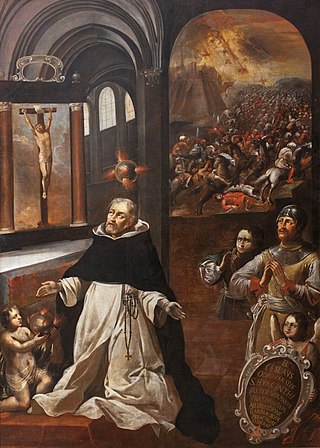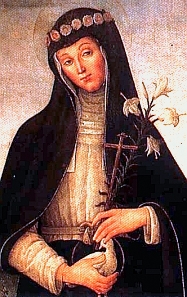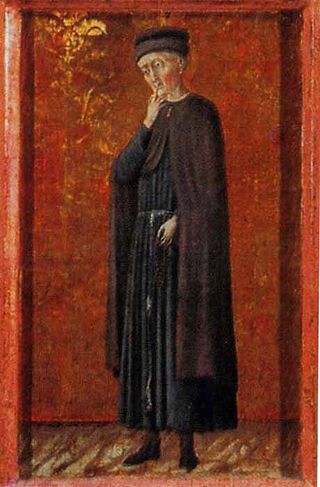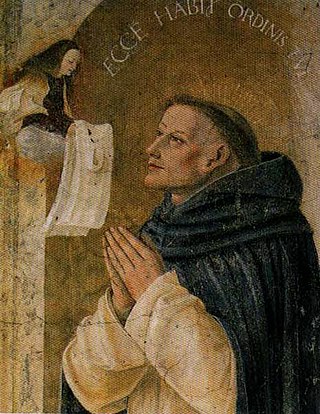
The Order of Preachers, commonly known as the Dominican Order, is a Catholic mendicant order of pontifical right that was founded in France by a Castilian priest named Dominic de Guzmán. It was approved by Pope Honorius III via the papal bull Religiosam vitam on 22 December 1216. Members of the order, who are referred to as Dominicans, generally display the letters OP after their names, standing for Ordinis Praedicatorum, meaning 'of the Order of Preachers'. Membership in the order includes friars, nuns, active sisters, and lay or secular Dominicans. More recently, there have been a growing number of associates of the religious sisters who are unrelated to the tertiaries.

Pope Benedict XI, born Nicola Boccasini, was head of the Catholic Church and ruler of the Papal States from 22 October 1303 to his death, in 7 July 1304.

Pope Gregory XV, born Alessandro Ludovisi, was the head of the Catholic Church and ruler of the Papal States from 9 February 1621 until his death in 1623. He is notable for founding the Congregation for the Propagation of the Faith, an organization tasked with overseeing the spread of Catholicism and missionary work. Gregory XV was also responsible for the canonization of Saints Ignatius of Loyola, Francis Xavier, Teresa of Ávila, and Philip Neri, which solidified his commitment to the Counter-Reformation.

Doctor of the Church, also referred to as Doctor of the Universal Church, is a title given by the Catholic Church to saints recognized as having made a significant contribution to theology or doctrine through their research, study, or writing.

Hyacinth was a Polish Dominican priest and missionary who worked to reform the women's monasteries in his native Poland. Educated in Paris and Bologna, he was a Doctor of Sacred Studies.

Saint Dominic,, also known as Dominic de Guzmán, was a Castilian Catholic priest and the founder of the Dominican Order. He is the patron saint of astronomers and natural scientists, and he and his order are traditionally credited with spreading and popularizing the rosary. He is alternatively called Dominic of Osma, Dominic of Caleruega, and Domingo Félix de Guzmán.

John of Wildeshausen, O.P., also called Johannes Teutonicus was a German Dominican friar, who was made bishop of Bosnia and later the fourth master general of the Dominican Order.

Ceslaus, O.P., was born in Kamień Śląski in Silesia, Poland, of the noble family of Odrowąż, and was a relative, possibly the brother, of Hyacinth of Poland.

The Third Order of Saint Dominic, also referred to as the Lay Fraternities of Saint Dominic or Lay Dominicans since 1972, is a Catholic third order which is part of the Dominican Order.

Louis Bertrand, OP was a Spanish Dominican friar who preached in South America during the 16th century, and is known as the "Apostle to the Americas". He is venerated as a saint by the Catholic Church.

Giovanni Dominici, OP was an Italian Catholic prelate and Dominican who became a cardinal. His ideas had a profound influence on the art of Fra Angelico, who entered the Dominicans through him.

Columba of Rieti, TOSD was an Italian religious sister of the Third Order of St. Dominic who was noted as a mystic. She was renowned for her spiritual counsel, devotion to the Blessed Sacrament, and fantastic miracles were attributed to her. She was beatified by the Catholic Church in 1625.

The 17 Thomasian Martyrs were the 12 Dominican priests, 1 Franciscan priest and 3 Dominican bishops who became administrators, professors, or students in the University of Santo Tomas in Manila, they are venerated in the Catholic Church regarded them as a martyrs and declared as a saints and blesseds by several popes throughout the 20th and 21st century, All of them gave up their lives for their Christian faith, some in Japan, others in Vietnam, and in the 20th century, in Spain during the Spanish Civil War. Lorenzo Ruiz de Manila was among the lay companions of the Thomasian Martyrs of Japan, their feast day is celebrated every year on November 6.

Francisca del Espíritu Santo de Fuentes was a Spanish Roman Catholic religious sister. She became the first prioress of the Congregation of the Dominican Sisters of St. Catherine of Siena in the Philippines.

Giacomo Salomoni, OP was an Italian Catholic priest and a professed member of the Order of Preachers. He was a noted ascetic known for being prone to ecstatic states on a frequent basis; he served as a prior of several convents until he settled in Forlì, where he remained until his death.

Augustin Kažotić was a Croatian prelate of the Catholic Church and professed member from the Order of Preachers who served as the Bishop of Lucera from 1322 until his death. Kažotić was a humanist and orator who had served first as the Bishop of Zagreb from 1303 until 1322. Kažotić studied in Paris before returning to his homeland where he began working in the missions and preaching in modern Bosnia. He was one of the first humanist figures to appear in southern Croatia.

Pietro Pettinaio was an Italian member of the Third Order of Saint Francis who worked as a comb-maker. He was well known both for his trade and for his decision to remain in silence while living among the Franciscans. He became known for his charisma and for his care of both the poor and the ill and was honored as a saint during his lifetime by the people of Siena.

Francesco Lippi was an Italian Roman Catholic professed religious from the Carmelites. He lived his life as a soldier before suffering the loss of sight at which point his healing led him down the path of repentance and into the Carmelites.

Giacomo Bianconi was an Italian Roman Catholic priest and a professed member of the Order of Preachers. Bianconi - who hailed from Umbria - joined the order in his adolescence and dedicated his pastoral career to his flock and on one notable occasion aided refugees when Frederick II sacked the area in 1248. He also combatted heresies and managed to convert one of their chief propagators while also distinguishing himself through his life of extreme poorness that went past the Dominican standards.

Reginald of Orleans, OP was an Italian Dominican friar and Catholic priest. He was one of the earliest members and a close collaborator of Saint Dominic.




















